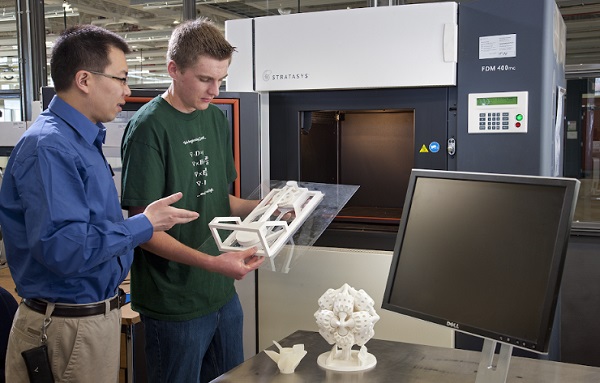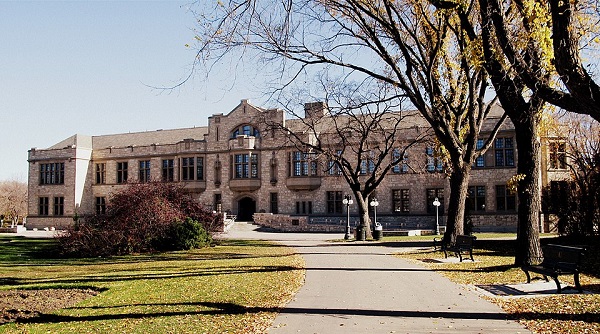Education
$13 million for RDP’s Centre for Innovation in Manufacturing-Technology Access Centre in Alberta Budget

Provincial funding to expand RDP’s Centre for Innovation in Manufacturing (CIM-TAC) will significantly boost applied learning and research opportunities
Expansion of Red Deer Polytechnic’s nationally recognized Technology Access Centre will provide more than 2,400 students direct and indirect innovative learning opportunities by 2030.
Red Deer Polytechnic (RDP) is celebrating a significant capital investment of $13 million by the provincial government to expand RDP’s Centre for Innovation in Manufacturing-Technology
Access Centre (CIM-TAC). The funding was announced today as part of the Government of Alberta’s 2024 budget.
“Red Deer Polytechnic is playing a critical role supporting technological innovation while creating opportunities for students. That’s why Alberta’s Government is making a strategic investment to expand the CIM-TAC and give RDP even greater capacity to train apprentices and help sectors across our economy remain competitive,” says the Hon. Rajan Sawhney, Minister of Advanced Education.
“We thank the Government of Alberta for the $13 million provided in Budget 2024 to expand our Centre for Innovation in Manufacturing–Technology Access Centre (CIM-TAC). This funding will help create new and innovative teaching and learning spaces at Red Deer Polytechnic, while expanding our applied research capacity to support Alberta based companies,” said Stuart Cullum, President of Red Deer Polytechnic.
“Because of this investment, Alberta based manufacturers across multiple sectors will have greater ability to develop, test and scale their ideas, while RDP students will be engaged at the forefront of made-in-Alberta technologies and manufacturing solutions. This expanded and enhanced innovation ecosystem will enhance productivity and social impact within our province,” said Cullum.
Students in a breadth of RDP’s programs and disciplines already benefit from education and skills-training opportunities within the CIM-TAC each year, through project work, internships, and workshops. The expanded CIM-TAC is anticipated to provide direct learning opportunities to 450 post-secondary students and indirect learning opportunities to an additional 2,000 students by 2030. These opportunities will afford RDP’s students direct interaction with community and industry partners to tackle real-world challenges in manufacturing and
advanced manufacturing. Additionally, over 500 junior and senior high school students will benefit from experiential learning within the CIM-TAC as part of dual-credit opportunities afforded through the Central Alberta Collegiate Institute (CACI).
RDP is Alberta’s third largest provider of skilled trades education. Learners enrolled in RDP’s apprenticeship and technology programs are among those who will benefit from the CIM-TAC expansion as this capital investment will support unique training opportunities.
“With the expansion of Red Deer Polytechnic’s CIM-TAC, our students will gain unparalleled access to advanced manufacturing technologies and immersive learning spaces. Students will have the hands-on experience and expertise needed to excel in the modern manufacturing sector. This expansion underscores our commitment to providing students with the tools and skills necessary to become industry-ready professionals, ensuring they emerge as highly sought-after innovators and contributors to Alberta’s economic prosperity,” says David Pye, Dean, RDP’s School of Trades and Technology.
The provincial Government’s $13 million investment in RDP’s CIM-TAC complements the recently announced historic $20 million gift to RDP from the Donald Family that will establish the Donald Family Institute for Healthtech Innovation. This parallel public and private funding support will be a game-changer for post-secondary training in central Alberta, in particular for healthcare providers and healthtech innovators.
“As RDP’s CIM-TAC grows capacity, it will undoubtedly provide new ways for students and faculty to engage in education and applied research with external health practitioners and researchers in this unique innovation ecosystem. Our students will have even more opportunities to gain valuable skills that prepare them for successful careers while also making meaningful contributions to Alberta’s healthcare sector,” says Heather Dirks, Interim Dean, RDP’s School of Health and Wellness.
Red Deer Polytechnic’s expansion plans for the CIM-TAC are in alignment with the Government of Alberta’s economic and social priorities, including the Ministry of Advanced Education’s 2030: Skills for Jobs Strategy.
This strategy outlines a need to increase student access, build capacity for skills training in technology and trades, and support research and commercialization through the post-secondary sector.
“As one of Canada’s Top 50 Research Polytechnics and Colleges, we already make a significant positive impact across our province and country,” says Dr. Tonya Wolfe, Associate Vice President, Applied Research.
“The future is very bright as we plan for the expansion of our Centre for Innovation in Manufacturing-Technology Access Centre. This means we can create even more impact in productivity in the manufacturing sector through collaboration between students, faculty and industry that help people solve challenges in their daily lives.”
The overall cost of the capital expansion of the CIM-TAC is projected to be approximately $21.3 million. This includes the $13 million provided by the Government of Alberta in Budget 2024, with $4.8 million in capital and equipment provided through Government of Canada grants, and $3.5 million from Red Deer Polytechnic’s own reserves. Construction on Red Deer Polytechnic’s CIM-TAC expansion is anticipated to begin in the fall of 2024.
Quick Facts:
• Red Deer Polytechnic’s expanded CIM-TAC will support a variety of sectors through advanced
manufacturing capabilities including energy innovation, transportation, aviation and agriculture. The Centre will also support RDP’s future expansion into more medical device manufacturing and healthcare innovations to support both patients and providers.
• RDP’s expansion of the CIM-TAC will grow the facility’s footprint from 15,000 square feet to
25,000 square feet.
• The CIM-TAC currently houses $7.6 million of advanced manufacturing equipment. As the facility expands, so too will RDP’s capacity to house additional technologies and equipment used for product development, advanced manufacturing and medical device manufacturing.
• In 2022, Red Deer Polytechnic attracted more than $2 million in applied research investment. RDP also completed 64 projects for 57 companies and participated in more than 1,300 engagements with industry partners.
• Since the CIM-TAC’s inception in 2009, Red Deer Polytechnic has supported more than 300 industry partners (including repeat clients).
Red Deer
Red Deer teacher one of 7 in Canada to receive National Award for Teaching Excellence in Physical Education

Scott Luck has been named as one of just seven recipients across Canada for the National Award for Teaching Excellence in Physical and Health Education presented by Physical and Health Education Canada
Whether it’s leading high-energy gym classes or helping students discover their passion for physical activity, PhysEd Specialist at École Central Middle Scott Luck has always focused on getting kids moving – and now, he’s being recognized for his efforts on a national level.
Scott has been named as one of just seven recipients across Canada for the National Award for Teaching Excellence in Physical and Health Education presented by Physical and Health Education Canada. The award honours exceptional teaching and leadership in promoting wellness and physical literacy in schools.
“I didn’t know that I was being nominated – I was extremely surprised when I was told I was a recipient,” said Scott. “I just go about doing my day-to-day and for others to consider me in that type of category is a big honour.”
While he had not met the other recipients before the awards ceremony, Scott said he was humbled to be in their company.
“To be grouped together with the other recipients is such an honour. They are all amazing individuals who do amazing things,” he said.
Scott’s journey to education wasn’t typical. Initially being accepted into a combined PhysEd and Education degree right out of high school, he was steered away from the field. Years later in his 20s, he returned to his calling and earned his After Degree in Education from the University of Alberta. He landed his first teaching job at the age of 28.
He began his career in Edmonton and quickly came to Red Deer teaching at Hunting Hills High School before joining École Central Middle, where he’s spent the past eight years helping students discover the joy of movement.
“I love being active. I love seeing kids be active, and figure out what they are good at. It’s extremely rewarding,” said Scott.
He believes physical and mental wellness are key to student success. “In order for a student to excel academically, they have to be well. Wellness for me is all about the balance between being physically active, mentally well, and the pursuit of happiness,” he said.
Amanda Wilson, Principal at École Central Middle, said Scott is an exceptional Phys Ed teacher who creates inclusive, high-quality programs that cater to widely diverse student needs.
“He adapts lessons using translation tools, tactile clues, auditory signals, and specialized equipment, ensuring all students, regardless of ability or challenges, can participate and experience success,” she said. “Scott goes above and beyond regularly for his students and for our school in the classroom as well as with extracurricular activities. He is instilling a lifelong love of physical activity, and transforming his students’ lives with his dedication and creativity and we are incredibly fortunate to have him at CMS.”
Aristotle Foundation
The University of Saskatchewan is on an ideological mission

By Peter MacKinnon
The program is part of an ideological crusade within our universities, one that includes identity-based admissions and faculty appointments, and discourages those who differ from speaking out or taking issue with its direction.
It needs to end
I must disclose my background here; I was employed by the University of Saskatchewan for 40 years including 13 years as president. The institution’s distinctive origins combined the development of liberal education with a responsibility to build the province’s agricultural industry, and it did the latter with world-class agricultural programs and research institutes, and with faculty and students of many backgrounds from around the globe.
Now, we are told, the academic personnel in this worldly environment require mandatory training on racism: an Anti-Racism/Anti-Oppression and Unconscious Bias Faculty Development Program. It is compulsory; those who decline its offerings will be shut out of collegial processes previously thought to be their right as tenured faculty.
It was earlier reported that the program emerged from collective bargaining at the initiative of the university’s faculty union; if so, this does not relieve the administration from responsibility; it signed the collective agreement.
“Program” is a euphemism. It is a propaganda module in which scholarly expertise and balance will not be found. It does not appear that the instructor has a university academic post and the program’s ideological hue is revealed in the two required readings, one by Idle No More co-founder Sheelah McLean whose theme is that the success of Saskatchewan’s white people is built on “150 years of racist, sexist and homophobic colonial practices.”
The second is by five “racialized” faculty who claim that Canadian university systems are rigged to privilege white people. Dissent, contrary views or even nuance are neither expected nor tolerated here. Opinions that are different are not on the reading list.
One participant, a law professor, was invited to leave after 30 minutes because he did not lend his voice to its purpose and orientation; he revealed that he was present because it was required. The purpose of the program is indoctrination and there is no room for dissent.
The program is part of an ideological crusade within our universities, one that includes identity-based admissions and faculty appointments, and discourages those who differ from speaking out or taking issue with its direction.
It is not present to the same degree in all of these institutions, but it is visible in most and prominent in many. It disparages merit, distorts our history and rests on the proposition that a white majority population has perpetrated a wide and pervasive racist agenda against others. It takes its conclusions as self-evident and not requiring evidence. It is authoritarian and intolerant, and should have no place in institutions committed to excellence and the search for truth.
The question, of course, is what is to be done. There is a view that “this too shall pass;” it is a fad that will recede in time.
But we must note, these are public institutions supported by tax dollars, and by the contributions of time and money by alumni and supporters. We should not tolerate their politicization and sidetracking of the academic mission in favour of the ideology on display here. The pushback should begin with governments and extend to others who care about these vital institutions.
But first the ideology must be recognized. There is no public uproar and little clamour from within the institutions; dissenting professors and students fear that negative professional and personal repercussions may follow. University-governing bodies stand down or away, not wanting to be involved in controversy. Resistance must come from outside the institutions: governments must insist that the propaganda must end, and they should be joined by alumni, supporters and the general public. The credibility of our universities depends on their willingness to say no.
Peter MacKinnon has served as president of three Canadian universities and is a senior fellow at the Aristotle Foundation for Public Policy. Photo: WikiCommons
-

 Addictions14 hours ago
Addictions14 hours agoMan jailed for trafficking diverted safer supply drugs, sparking fresh debate over B.C. drug policies
-

 Alberta16 hours ago
Alberta16 hours agoHow Trump and Alberta might just save Canada
-

 Business15 hours ago
Business15 hours agoThe Liberals Finally Show Up to Work in 2025
-

 Alberta14 hours ago
Alberta14 hours agoJann Arden’s Rant Will Only Fuel Alberta’s Separation Fire
-

 Bruce Dowbiggin11 hours ago
Bruce Dowbiggin11 hours agoCaitlin Clark Has Been The Real Deal. So Her WNBA Rivals Hate Her
-

 Banks12 hours ago
Banks12 hours agoCanada Pension Plan becomes latest institution to drop carbon ‘net zero’ target
-

 Daily Caller13 hours ago
Daily Caller13 hours agoThere’s A Catch To California’s Rosy Population Stats
-

 espionage2 days ago
espionage2 days agoTrudeau Government Unlawfully Halted CSIS Foreign Operation, Endangering Officers and Damaging Canada’s Standing With Allies, Review Finds




